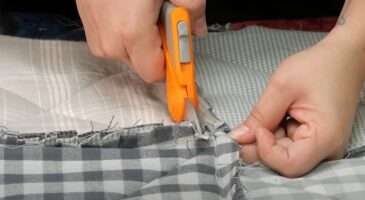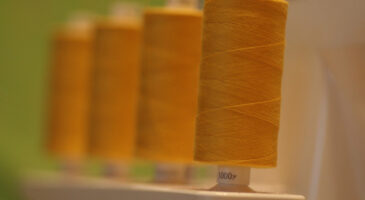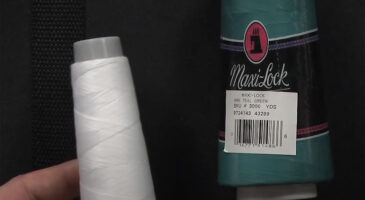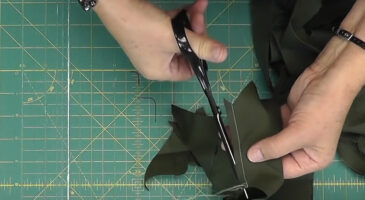There are lots of techniques used by designers in the world over to create designs on fabrics. One of them is cross stitching: a type of hand embroidery in which stitches shaped like an X in a tile are used to create quaint pictures on fabrics.
Just like many other techniques, for example, screen printing, cross stitching has tools that are specially designed for the craft, one of which includes the cross stitching needle. Cross stitching needle is a vital tool that every cross stitcher must have in their toolbox if they want to create stunning designs.
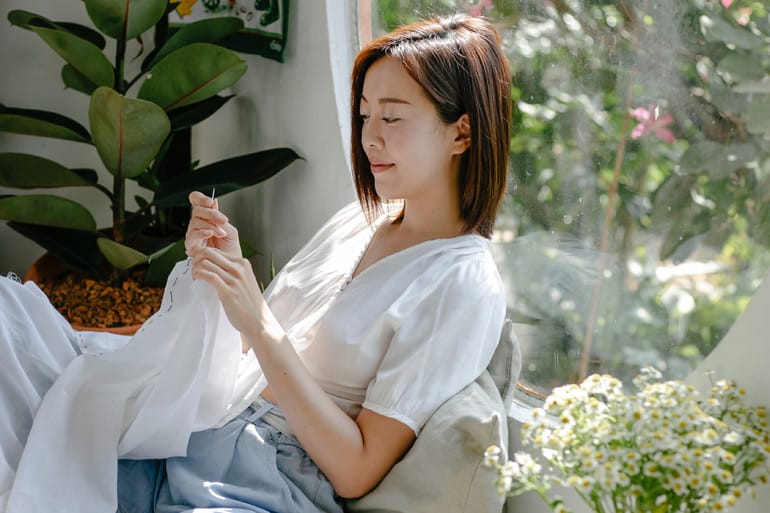
Once you know your craft, this tool is straightforward to use but what people usually find difficult is how to thread a cross stitch needle, especially the first timers. This helpful article is written to help people solve this problem as well as related ones.
How do you thread a cross-stitch needle?
- After getting the right cross stitch needle, you have to make sure you have the right thread because the cross stitch thread differs from the regular one used for sewing: six strands of threads are bunched together to create a thread.
- Determine the amount of thread that will suffice you throughout your cross stitching work and unroll the exact length or more from the embroidery thread and cut.
- A typical embroidery thread has 6 strands, but it is not advisable to use the whole strands. Instead, use only a strand or two so that your designs will not be too thick.
- Make a knot at any of the two ends of the thread to prevent the thread from falling once you insert it through the needle eye and start to stitch. After that, insert the knotted end of the thread into the needle eye and begin to stitch.
How to string a cross stitch needle
- Wrap the string tightly around your cross-stitch needle.
- Gently slide the string off the needle so that the loop created by wrapping the string will remain intact, and hold the loop tightly in your fingers.
- Insert the loop into the needle eye and drag the string through the needle.
How to start a cross stitch needle
After threading your needle, the next step for you will be to determine where to start your cross-stitching. Generally, cross stitching is made in rows, and you will either move from left to right or vice versa to stitch, so it is always best to check the stitching chart to determine where to start.
If you are beginning from the fabric’s backside, bring the needle upward through a hole and towards the front of the material, and leave close to one inch of the thread at the back.
Pass the needle through another hole diagonally across from your starting point to form a warp half cross stitch. Secure the thread tail by holding on to it, so it doesn’t slip.
Bring the needle back up to begin the second half stitching through another hole right below the last hole used. Turn the fabric to the other side before tightening the stitch to check if the stitch traps the thread tail, and then you can continue to stitch along the row to create a series of half-cross stitches.
Make another series of half-cross stitches over the row in the other direction.
How do you make a cross stitch needle case
Items needed
- 14-count Aida fabric
- Embroidery floss
- Embroidery needle
- Felt
- Iron-on interfacing
- Fabric scissors
- Iron
Steps involved
- Prepare 2 finished pieces of Aida fabric comprising 1 piece each for the inside and the outside of the case; they must be the same size.
- Starting from the edges of the outside piece, count 2 rows, then make a border around the design with a backstitch. Create the same border with the backstitch on the inside part as well.
- Trim the fabric around each piece leaving close to half of the materials (since we are using 14 counts here, that makes 7 squared ideal for this illustration) out of the backstitched order lines created.
- Cut your interfacing to the exact size of the backstitch borderline and attach it to the wrong side of the fabric on both sides with an iron. Then trim off the corner.
- Fold the edges of the sewing line backward and press them down with your finger. This should be done for all the sewing line pieces.
- Make a knot with 2 strands of embroidery floss (note: it must have the same color as the backstitching line) and begin to sew the outside and the inner part of the pieces together with a whip-stitch. To do this effectively, take a stitch below any of the backstitched threads of the outside portion and also any stitch from the inside piece. Continue in this pattern until the whole 4 sides are stitched.
- Cut a felt piece that will be a little bit smaller than the needle case using fabric scissors or pinking shears.
- Stitch along the middle of the felt and through all the fabric layers. You can either sew with your hand or with the sewing machine.
- Make thread ties by cutting 2 lengths of embroidery thread (6-strands) that are about 10″ long. Fold one of the lengths into half to have 2 thread ends on one side and a loop on the other. Insert the ends into a large needle and work the needle through every single layer on the needle case’s front edge.
- Pull the 2 ends of the thread through the loop, then pull tightly. It will fit perfectly on the needle case side. Make a knot at the thread end to secure the two loose ends. Then repeat the same for the other 10 lengths and attach it to the needle care at the back. Once the thread is attached, you can tie the two strings to close the case/book.
